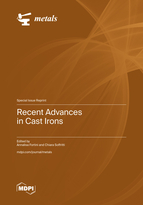Recent Advances in Cast Irons
A special issue of Metals (ISSN 2075-4701). This special issue belongs to the section "Metal Casting, Forming and Heat Treatment".
Deadline for manuscript submissions: closed (31 December 2022) | Viewed by 20166
Special Issue Editors
Interests: metallurgical characterization of steels and cast irons; mechanical properties; surface engineering; shape memory alloys
Special Issues, Collections and Topics in MDPI journals
Interests: archaeometallurgy; heritage science; metal alloys; chemical composition; microstructure; heat treatment; corrosion products; restoration solutions
Special Issues, Collections and Topics in MDPI journals
Special Issue Information
Dear Colleagues,
Cast irons are the most used casting alloys after steels thanks to their excellent castability, which makes it possible to obtain near net shape components with a complex geometry directly by moulding, without subsequent forging or machining processes. Cast irons also offer the design engineer a low-cost material with good machinability, vibration damping and corrosion strength, and a relatively high wear resistance because graphite acts as a self-lubricating system.
For a certain chemical composition, the optimization of the process parameters, solidification conditions and heat treatment is essential to achieve the optimal combination of microstructure and mechanical properties. The aim of this Special Issue “Recent Advances in Cast Iron” is to collect full papers, communications and review articles highlighting recent achievements on cast irons, with a special focus on the relationship between microstructural features and mechanical behaviour. Submissions of works dealing with corrosion resistance and coating systems for applications in different industrial fields are also encouraged.
We are pleased to invite you to submit original research articles for this Special Issue, to be published in the open-access journal Metals. High-quality papers from researchers in the scientific community and industry are welcome.
Dr. Annalisa Fortini
Dr. Chiara Soffritti
Guest Editors
Manuscript Submission Information
Manuscripts should be submitted online at www.mdpi.com by registering and logging in to this website. Once you are registered, click here to go to the submission form. Manuscripts can be submitted until the deadline. All submissions that pass pre-check are peer-reviewed. Accepted papers will be published continuously in the journal (as soon as accepted) and will be listed together on the special issue website. Research articles, review articles as well as short communications are invited. For planned papers, a title and short abstract (about 100 words) can be sent to the Editorial Office for announcement on this website.
Submitted manuscripts should not have been published previously, nor be under consideration for publication elsewhere (except conference proceedings papers). All manuscripts are thoroughly refereed through a single-blind peer-review process. A guide for authors and other relevant information for submission of manuscripts is available on the Instructions for Authors page. Metals is an international peer-reviewed open access monthly journal published by MDPI.
Please visit the Instructions for Authors page before submitting a manuscript. The Article Processing Charge (APC) for publication in this open access journal is 2600 CHF (Swiss Francs). Submitted papers should be well formatted and use good English. Authors may use MDPI's English editing service prior to publication or during author revisions.
Keywords
- Cast iron
- Microstructure
- Heat treatment
- Mechanical properties
- Tribological behaviour
- Corrosion resistance
- Coatings
- Casting
- Process parameters
- Modelling







